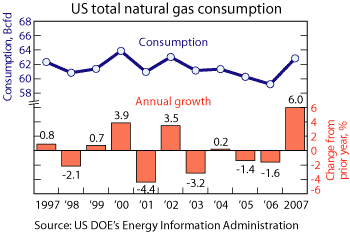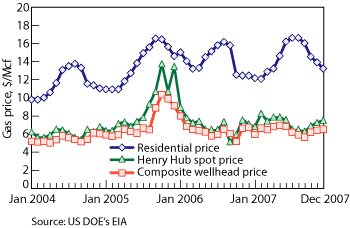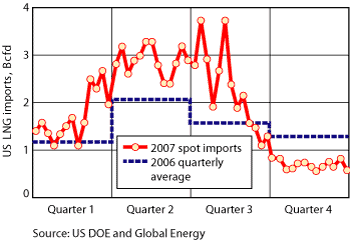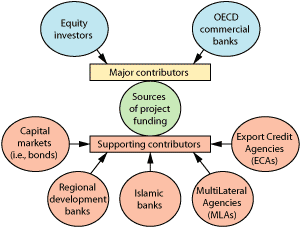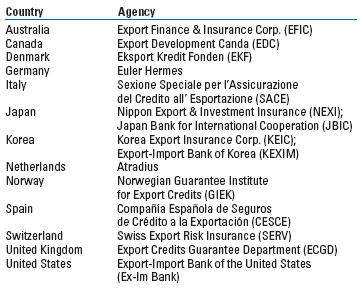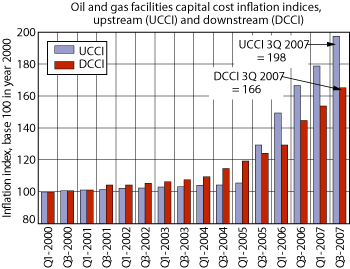Competition for tight LNG supply heats up
Though demand is high, the challenges of funding large-scale LNG facilities are stifling investment and delaying some projects.
Though demand is high, the challenges of funding large-scale LNG facilities are stifling investment and delaying some projects.David Wood, David Wood & Associates, Lincoln, UK In 2007, the extent to which LNG has diversified and become a truly global industry manifested itself more than in previous years. Supply was tight, with several liquefaction projects late onstream or experiencing teething problems in initial operations. Conversely, demand was strong in most markets, particularly in Asia in the second half of the year, pushing spot prices to unprecedented levels and diverting deliveries from the Atlantic to the Pacific markets. As more LNG receiving terminals under construction come onstream, it is clear that North America, Europe and Asia are competing vigorously for limited supply, putting upward pressure on prices. Cost inflation, project budget overruns and the deepening global credit squeeze have made funding large-scale LNG facilities costlier and riskier for equity and debt investors. This has led to some final investment decisions-and LNG import projects without access to secure supply contracts-being delayed. ATLANTIC MARKET Substantial demand growth in Europe and the US for imported gas, in part fueled by dwindling domestic production, is driving LNG demand in the Atlantic Basin. The EIA reported in January 2008 that the US had imported about 781 Bcf of LNG in 2007, about 34% more than it did in 2006. Indeed, in 2007 many LNG cargoes were diverted from Europe to the US (by BG and others) to benefit from strong prices of $6-8/MMBtu in the first half of the year and to compensate for weaker short-term gas demand in Europe. This highlights growing competition for short-term spot LNG cargoes among North America, Europe and Asia. The growing number of receiving terminals in both markets and new entrant suppliers (e.g., Equatorial Guinea and Norway following Egypt) will continue to feed this competition. Atlantic LNG (ALNG) of Trinidad and Tobago exported some 235 cargoes of LNG in 2007, with 70% of them US-bound, making ALNG the major supplier of to the US by some distance. However, an independent gas reserve audit conducted by Ryder Scott for the Energy Ministry has raised concerns about dwindling gas reserves and caused plans for an additional LNG train to be shelved. The audit found that reserves declined by 3 Tcf from 2005 to 2007 and that, based on a production rate of 4.5 Bcfd, gas reserves will be depleted by 2020 unless new reserves are discovered. This has significance for the US as well as Trinidad and Tobago, as it may have to replace these favorably located gas imports with more distant and probably geopolitically unstable supplies over the next decade or so. Production from NLNG Trains 4 and 5 in Nigeria has been boosting LNG supply for Shell, Total and Eni, and Train 6 exported its first cargo in January 2008, adding further Atlantic Basin capacity along with Norway’s SnØhvit plant. PACIFIC MARKET Demand in the Pacific Basin, dominated by oil-indexed, long-term contracts, had been progressing at a slower pace up to mid-2007, but has come to life in recent months with competition for short-term cargoes from Japan and South Korea doubling prices. New LNG supply deals to China may accelerate the expansion of that market. In early September 2007, PetroChina agreed to buy 174-262 MMcfy of LNG over 15-20 yr from the Woodside-operated Browse project on Australia’s North West Shelf (NWS). According to the Australian press, PetroChina agreed to pay US$7-9 (A$8.50-11) per MMBtu for Browse gas, compared with prevailing LNG prices in Asia of US$8-10/MMBtu for long-term contracts. Also in early September, Shell agreed to sell 87 MMcfy of LNG over 20 years from Australia’s Gorgon Field to PetroChina, reportedly at a substantial price. Since the low LNG prices agreed on with China in 2003, price has been a stumbling block for many would-be suppliers to China. Despite these China deals, at the moment there remains a queue of supply projects with capacities not yet fully subscribed. These projects include a number in Australia including those mentioned above, two rival projects in Papua New Guinea-InterOil and ExxonMobil-and BP’s Tangguh project in Indonesia. Additionally, substantial additional liquefaction capacity of Sakhalin II due onstream in 2008 is not yet fully subscribed. Hence many of the Pacific Basin suppliers are positioning themselves for entry into the potentially lucrative western North American LNG import market. According to the EIA’s short-term energy outlook released in January 2008, natural gas consumption in the US grew at a faster rate in 2007 than in any other year in the previous decade (Fig. 1), and the EIA forecasts further modest growth in 2008 and 2009. Natural gas prices in the US remained relatively stable throughout 2007, in spite of increased demand, which was partially satisfied by increased LNG imports, Fig. 2. This contrasts markedly with East Asia, where spot LNG cargoes were being purchased at between $15/MMBtu and $18/MMBtu from November 2007 to January 2008. Increased gas demand and tighter supplies are placing upward pressure on US forward gas prices. However, the forward prices for winter 2008/2009 are less than half of prevailing short-term prices being paid for LNG cargoes in East Asia.
The bulk of the 2007 LNG imports to the US occurred between March and September, Fig. 3. Very few cargoes were tempted away from Asia and Europe during the winter. This is an issue the US will need to address if LNG is to be available in the future to meet winter demand peaks.
In the tight short-term Asian LNG market of January 2008, Japanese buyers were reported to be paying some $18/MMBtu for spot LNG cargoes for January/February delivery. A spot LNG cargo was also purchased for the Indian market in January 2008 at a price reported to be about $16.50/MMBtu. This latter purchase price is a long way from the low fixed price contract secured by Petronet for India’s first LNG import project in 2004. It indicates that India, like China, is taking a more realistic approach to securing LNG supply in the prevailing seller’s market. GAZPROM EXTENDS INFLUENCE The future for the major IOCs in Russia appears to be with Gazprom very much in the driving seat. Shell turned over the reins of Sakhalin II to the Russian company in January 2007 following long struggles to maintain control through production-sharing agreements, and BP ceded control of its East Siberian Kovykta asset to Gazprom in June. Both companies are on record as seeking international cooperation agreements with Gazprom to maintain future position in those assets. Gazprom is keen to develop its international LNG business, opening access to gas markets outside Europe. Hence, cooperation with Total, BP and Shell in gas liquefaction projects in North Africa, the Middle East and West Africa can be expected. Gazprom was also one of the winners of the gas exploration bidding announced in Libya in December 2007, outbidding a host of IOCs to secure much-sought-after acreage. This further demonstrates Gazprom’s intention to participate more actively in the international upstream gas sector and gain more control of gas resources that compete with its own for import into Europe. Another example of this is Gazprom’s reported ongoing negotiation of a $2.5 billion deal to invest in gas development projects in Nigeria. Nigeria is also contemplating a trans-Sahara gas pipeline to transport gas through Algeria to Europe. Gazprom’s potential control of Nigerian gas resources is of concern to EU nations from a security-of-supply perspective. GROWING FINANCE CHALLENGES LNG projects are very capital intensive, with a very long period of capital expenditure during the design, procurement and construction phases before they generate any revenue. Due to their large size and complexity, they are usually multi-participant projects involving upstream and downstream companies with governments of the gas supply countries, or their NOCs, often involved. It has become common to adopt a project financing approach, involving equity and debt funding with limited recourse to the other assets of the participants for security, for such projects. This is partly because the large required investments exceed the available internal financing of all but the very largest international energy companies, but also to reduce risk for the equity investors, which are usually IOCs. Most large upstream energy projects have a loan-collateral basis that can be evaluated-i.e., the recoverable hydrocarbon reserves that will be produced by the project. Due to the very large investment and the large volume of energy reserves that will be processed by the typical gas liquefaction project, the recoverable hydrocarbon reserves cannot be considered liquid collateral in the normal sense. This leads to a project without a prime source of loan collateral for project financing; i.e., without the project, the gas reserves have little value and their ownership usually remains with the sovereign state. A gas liquefaction plant that is not complete and capable of meeting its sales contract requirements has essentially no value as an asset against a loan. The salvage value of even the best available gas processing technology installed in a very remote area is very low. The only loan value is essentially the sales revenue generated after the plant begins operation. Despite this, it has become increasingly common for grass-roots, baseload gas liquefaction plants and LNG plant expansion projects to obtain limited and even fully non-recourse project financing. This has been possible because the main source of comfort to the equity investors and debt financiers has been the firm, long-term LNG sales offtake agreement (Sale and Purchase Agreement, or SPA) between sellers and buyers. Historically, SPAs have usually involved two or three independent, credit-worthy LNG buyers willing to agree to take-or-pay conditions, a floor price and indexation of the LNG to crude oil, fuel oil or distillate fuels. In recent years, several LNG supply chains involving SPAs with diluted take-or-pay terms, no floor price and with less creditworthy participants have secured project finance funding. This type of exposure for both the equity participants and the international financing community requires very conservative project evaluation and comprehensive risk analysis incorporating technical, commercial and political uncertainties. In the past decade, LNG financings have gone beyond traditional commercial banking for lending, Fig. 4. This is driven primarily by challenges posed by high-political-risk projects. Export Credit Agencies (ECAs), a traditional resource for political risk insurance in developing markets, have also provided direct debt finance and encouraged commercial banks into projects by removing some of the credit and political risks posed by some host countries, Table 1. In times of high costs and rapid inflation, ECAs continue to play an important role in financing LNG projects.
Multilateral Lending Agencies (MLAs), such as regional and international development banks (e.g., the World Bank, the European Bank for Reconstruction and Development, the African Development Bank) have also provided some funding to developing countries for both LNG and pipeline gas projects in recent years. During the same period, Islamic banks, benefiting from deposits from oil-rich clients, have invested heavily in the Middle East LNG sector. Such lenders, although content to join syndicated loans, have yet to act as lead arrangers. Consequently, they have depended on the risk appetite of the traditional lead energy banks in selecting projects deemed worthy of debt finance. Although raising and securing finance for gas liquefaction projects have historically been a challenge, the problem has become more difficult in recent years for several reasons:
These challenges have been exacerbated by the US sub-prime and global banking crisis of late 2007, which has led to debt finance generally becoming more expensive and difficult to secure. Together, these factors are making it increasingly difficult to raise project finance on favorable terms for all but the most technically and commercially robust liquefaction projects. It is considered telling that fewer newbuild gas liquefaction projects have been sanctioned by a positive final investment decision in the past two years than in 2005.
|
|||||||||||||||||||||||||||||||||||||||
- Prices and governmental policies combine to stymie Canadian upstream growth (February 2024)
- U.S. producing gas wells increase despite low prices (February 2024)
- U.S. drilling: More of the same expected (February 2024)
- U.S. oil and natural gas production hits record highs (February 2024)
- U.S. upstream muddles along, with an eye toward 2024 (September 2023)
- Canada's upstream soldiers on despite governmental interference (September 2023)
- Applying ultra-deep LWD resistivity technology successfully in a SAGD operation (May 2019)
- Adoption of wireless intelligent completions advances (May 2019)
- Majors double down as takeaway crunch eases (April 2019)
- What’s new in well logging and formation evaluation (April 2019)
- Qualification of a 20,000-psi subsea BOP: A collaborative approach (February 2019)
- ConocoPhillips’ Greg Leveille sees rapid trajectory of technical advancement continuing (February 2019)

